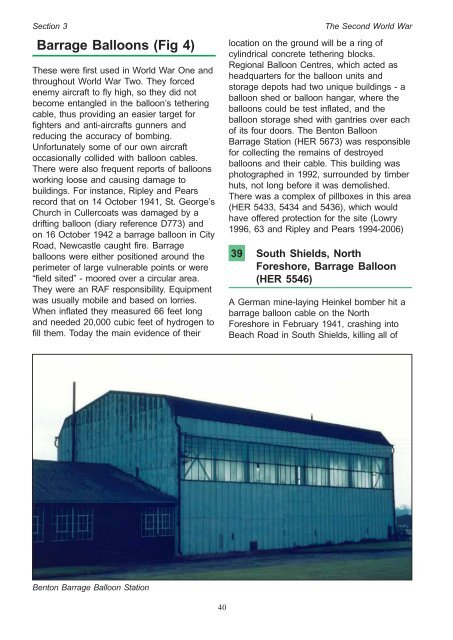TWENTIETH CENTURY DEFENCE SITES of TYNE and WEAR
TWENTIETH CENTURY DEFENCE SITES of TYNE and WEAR
TWENTIETH CENTURY DEFENCE SITES of TYNE and WEAR
Create successful ePaper yourself
Turn your PDF publications into a flip-book with our unique Google optimized e-Paper software.
Section 3 The Second World War<br />
Barrage Balloons (Fig 4)<br />
These were first used in World War One <strong>and</strong><br />
throughout World War Two. They forced<br />
enemy aircraft to fly high, so they did not<br />
become entangled in the balloon’s tethering<br />
cable, thus providing an easier target for<br />
fighters <strong>and</strong> anti-aircrafts gunners <strong>and</strong><br />
reducing the accuracy <strong>of</strong> bombing.<br />
Unfortunately some <strong>of</strong> our own aircraft<br />
occasionally collided with balloon cables.<br />
There were also frequent reports <strong>of</strong> balloons<br />
working loose <strong>and</strong> causing damage to<br />
buildings. For instance, Ripley <strong>and</strong> Pears<br />
record that on 14 October 1941, St. George’s<br />
Church in Cullercoats was damaged by a<br />
drifting balloon (diary reference D773) <strong>and</strong><br />
on 16 October 1942 a barrage balloon in City<br />
Road, Newcastle caught fire. Barrage<br />
balloons were either positioned around the<br />
perimeter <strong>of</strong> large vulnerable points or were<br />
“field sited” - moored over a circular area.<br />
They were an RAF responsibility. Equipment<br />
was usually mobile <strong>and</strong> based on lorries.<br />
When inflated they measured 66 feet long<br />
<strong>and</strong> needed 20,000 cubic feet <strong>of</strong> hydrogen to<br />
fill them. Today the main evidence <strong>of</strong> their<br />
Benton Barrage Balloon Station<br />
40<br />
location on the ground will be a ring <strong>of</strong><br />
cylindrical concrete tethering blocks.<br />
Regional Balloon Centres, which acted as<br />
headquarters for the balloon units <strong>and</strong><br />
storage depots had two unique buildings - a<br />
balloon shed or balloon hangar, where the<br />
balloons could be test inflated, <strong>and</strong> the<br />
balloon storage shed with gantries over each<br />
<strong>of</strong> its four doors. The Benton Balloon<br />
Barrage Station (HER 5673) was responsible<br />
for collecting the remains <strong>of</strong> destroyed<br />
balloons <strong>and</strong> their cable. This building was<br />
photographed in 1992, surrounded by timber<br />
huts, not long before it was demolished.<br />
There was a complex <strong>of</strong> pillboxes in this area<br />
(HER 5433, 5434 <strong>and</strong> 5436), which would<br />
have <strong>of</strong>fered protection for the site (Lowry<br />
1996, 63 <strong>and</strong> Ripley <strong>and</strong> Pears 1994-2006)<br />
39 South Shields, North<br />
Foreshore, Barrage Balloon<br />
(HER 5546)<br />
A German mine-laying Heinkel bomber hit a<br />
barrage balloon cable on the North<br />
Foreshore in February 1941, crashing into<br />
Beach Road in South Shields, killing all <strong>of</strong>

















